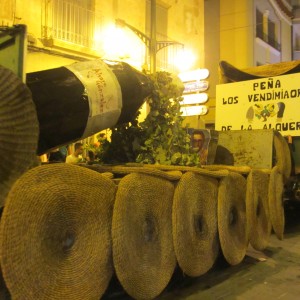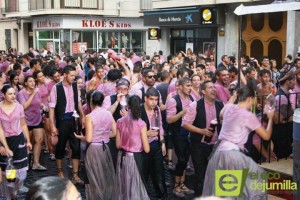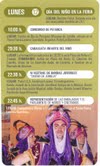I’ve been enjoying the fiestas so much that I nearly forgot to post part two! Jumilla certainly knows how to put on a good party and one that people of all ages can enjoy. The next two days though are definitely aimed at the youngest members of the family.
Wednesday 15 August 11.00 to 14.00
The Feria infantil – Children’s Fair – will be taking place in the playground of IES Arzobispo Lozano and entry is free. School was never this much fun!
There are a couple of intriguingly titled competitions on the Paseo Poeta Lorenzo Guardiola in the early evening. At 17.30 “La uva caliente” takes place and then at 18.30 “Mosto Pong”. I may go along just to see what they’re all about!
Thursday 16 August
This day has been designated the day of the child, as they are offering a 2 x 1 deal on all fairground rides, however it’s also a good day for adults, with the Cabalgata Tradicional.
Cabalgata Tradicional 20.30
Jumilla is renowned for its Gran Cabalgata with lots of wine throwing (more of that later!) but this is my favourite procession. The parade of decorated floats starts near the tourist office and slowly makes it way along Cánovas del Castillo, eventually finishing near the indoor market. I say slowly, because the participants are busy handing out sangria, wine and snacks to the spectators, as well as sampling some themselves and dancing to the music. It’s a great carnival atmosphere.

23.30
If you feel like partying a bit longer, there is a festival of local groups in the Jardín del Rey Don Pedro. There will be free entry to the garden until it’s full, however if you can find a spare seat in one of the bars outside you can then enjoy a drink while listening to the music.
Friday 17 August 20.00
Another favourite of mine is the parade of horses and carriages, with many of the participants dressed in traditional costume. I’m hoping that some of the riders will show off their horses’ capabilities as they’ve done in previous years. I enjoy watching horses dance as much as I enjoy watching human flamenco dancers.
23.30
I’m a bit of a fan of Al Golpe, who play flamenco style music that is bound to get the locals up on their feet. They will be playing on the Paseo Poeta Lorenzo Guardiola. If you’re lucky, you might even see me trying out my dance steps there!
Saturday 18 August 19.00
The infamous Gran Cabalgata will leave from Avenida Reyes Católicas, with plenty of wine throwing as well as wine drinking. This is for the young as well as the young in heart. One word of advice for the ladies: don’t wear your best white summer dress unless you want it to change into a pink one! The good news is that there will be showers outside the market when you reach the end of the parade. The other good news is that there will be free music at the Festival Tinto Rock, starting at 23.30. Enjoy!

Sunday 19 August 20.00
The last day of the Feria and Fiestas of Jumilla is a reminder that these are held to honour the patron saint of Jumilla, Nuestra Señora la Virgen de la Asunción. After mass at the Parroquia Mayor de Santiago, the statue of Our Lady will be carried to the Ermita de San Agustín.
Concert 22.00
The final free concert will take place in the Jardín Rey Don Pedro, with the singer Maribel Castillo performing coplas and spanish songs. That isn’t the last act though, as at 00.30 there will be a firework display at the municipal sports stadium.
!Feliz Fiestas!
Click on the following link to see the street map of Jumilla if you are unfamiliar with the town and would like to join in our fiestas. If you would like a free guided walk around Jumilla, either during the fiestas or at a later date, please contact me via the Contact page.



































